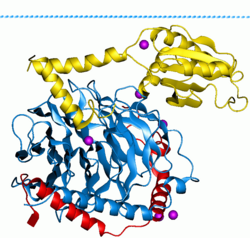
Back بروتين G Arabic G-protein BS Proteïna G Catalan G protein Czech G-Proteine German Proteína G Spanish G-valgud Estonian G proteina Basque جیپروتئین Persian G-proteiini Finnish



G proteins, also known as guanine nucleotide-binding proteins, are a family of proteins that act as molecular switches inside cells, and are involved in transmitting signals from a variety of stimuli outside a cell to its interior. Their activity is regulated by factors that control their ability to bind to and hydrolyze guanosine triphosphate (GTP) to guanosine diphosphate (GDP). When they are bound to GTP, they are 'on', and, when they are bound to GDP, they are 'off'. G proteins belong to the larger group of enzymes called GTPases.
There are two classes of G proteins. The first function as monomeric small GTPases (small G-proteins), while the second function as heterotrimeric G protein complexes. The latter class of complexes is made up of alpha (Gα), beta (Gβ) and gamma (Gγ) subunits.[1] In addition, the beta and gamma subunits can form a stable dimeric complex referred to as the beta-gamma complex .[2]
Heterotrimeric G proteins located within the cell are activated by G protein-coupled receptors (GPCRs) that span the cell membrane.[3] Signaling molecules bind to a domain of the GPCR located outside the cell, and an intracellular GPCR domain then in turn activates a particular G protein. Some active-state GPCRs have also been shown to be "pre-coupled" with G proteins, whereas in other cases a collision coupling mechanism is thought to occur.[4][5][6] The G protein triggers a cascade of further signaling events that finally results in a change in cell function. G protein-coupled receptors and G proteins working together transmit signals from many hormones, neurotransmitters, and other signaling factors.[7] G proteins regulate metabolic enzymes, ion channels, transporter proteins, and other parts of the cell machinery, controlling transcription, motility, contractility, and secretion, which in turn regulate diverse systemic functions such as embryonic development, learning and memory, and homeostasis.[8]
- ^ Hurowitz EH, Melnyk JM, Chen YJ, Kouros-Mehr H, Simon MI, Shizuya H (April 2000). "Genomic characterization of the human heterotrimeric G protein alpha, beta, and gamma subunit genes". DNA Research. 7 (2): 111–20. doi:10.1093/dnares/7.2.111. PMID 10819326.
- ^ Clapham DE, Neer EJ (1997). "G protein beta gamma subunits". Annual Review of Pharmacology and Toxicology. 37: 167–203. doi:10.1146/annurev.pharmtox.37.1.167. PMID 9131251.
- ^ "Seven Transmembrane Receptors: Robert Lefkowitz". 9 September 2012. Retrieved 11 July 2016.
- ^ Cite error: The named reference
Kou Qinwas invoked but never defined (see the help page). - ^ Tolkovsky AM, Levitzki A (1978). "Mode of coupling between the beta-adrenergic receptor and adenylate cyclase in turkey erythrocytes". Biochemistry. 17 (18): 3795–3810. doi:10.1021/bi00611a020. PMID 212105.
- ^ Boltz HH, Sirbu A, Stelzer N, de Lanerolle P, Winkelmann S, Annibale P (2022). "The Impact of Membrane Protein Diffusion on GPCR Signaling". Cells. 11 (10): 1660. doi:10.3390/cells11101660. PMC 9139411. PMID 35626696.
- ^ Reece J, C N (2002). Biology. San Francisco: Benjamin Cummings. ISBN 0-8053-6624-5.
- ^ Neves SR, Ram PT, Iyengar R (May 2002). "G protein pathways". Science. 296 (5573): 1636–9. Bibcode:2002Sci...296.1636N. doi:10.1126/science.1071550. PMID 12040175. S2CID 20136388.